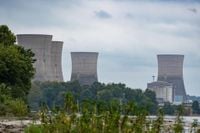The infamous Three Mile Island nuclear power plant in Pennsylvania is poised for a dramatic new chapter, thanks to a $1 billion federal loan aimed at restarting one of its dormant reactors. The move, announced in mid-November 2025 by the U.S. Department of Energy, marks a significant investment not only in nuclear energy, but in the future of America’s rapidly expanding artificial intelligence sector. The project has drawn both enthusiastic support and lingering skepticism from local residents, reigniting debates over nuclear safety, economic growth, and the nation’s energy priorities.
Located along the Susquehanna River, Three Mile Island has long been a symbol of both the promise and peril of nuclear power. In 1979, the plant became the site of the worst nuclear accident in U.S. history when one of its two reactors, known as Reactor 2, partially melted down and released radioactive material into the environment. While subsequent studies found minimal long-term health impacts for people living nearby, the incident left an indelible mark on the American psyche and on nuclear policy nationwide.
Now, more than four decades later, the other reactor at the site—Reactor 1, which ceased operations in 2019 but was never fully decommissioned—is set to come back online. The facility is being rebranded as the Crane Clean Energy Center, and the restart is expected to be completed by 2027, pending approval from the U.S. Nuclear Regulatory Commission.
According to the Pennsylvania Capital-Star, the $1 billion loan comes through the Trump administration’s Energy Dominance Financing Program, a federal initiative designed to boost energy infrastructure capacity, especially to meet the surging power needs of the U.S. artificial intelligence industry. The revived reactor will provide 800 megawatts of baseload power to the PJM Interconnection region, which spans much of the Mid-Atlantic. That’s enough electricity to power roughly 800,000 homes—or, in this case, to supply Microsoft data centers that are driving the next generation of AI development.
“Constellation’s restart of a nuclear power plant in Pennsylvania will provide affordable, reliable, and secure energy to Americans across the Mid-Atlantic region,” declared U.S. Energy Secretary Chris Wright in a press release, as reported by multiple outlets including PennLive and the Capital-Star. “It will also help ensure America has the energy it needs to grow its domestic manufacturing base and win the AI race.”
The project is being led by Constellation Energy Generation LLC, which has already ramped up staffing at the site to 80 percent, with about 500 full-time employees onsite and plans to employ 3,400 contractors over the course of the restart. “The federal government sees this restart project as a rock-solid investment,” said Dave Marcheskie, Constellation’s Community Relations Manager, in comments to local news outlet WGAL. “With 3,400 contractors throughout the duration of this project, they’re going to stay in the local hotels, going to the local shops, dealing with that influx of economic investment.”
Local officials have also touted the economic benefits. “It’s the jobs. It’s the economic boom. It’s everything that goes with this,” said State Representative Tom Mehaffie, who represents the area. “So by government loaning the money, helping out in this, you know, they’re getting the money back that way.”
Constellation has emphasized that the federal loan will reduce overall borrowing costs for the project, ultimately benefiting both the company and taxpayers. “We’re appreciative of [the loan],” said Mark Rodgers, a spokesperson for Constellation, in an interview with the Pennsylvania Capital-Star. “It’ll be helpful to Constellation. And for the government, we’re going to pay it back in full with interest, so ultimately the taxpayer will get a return.”
But not everyone is convinced that the restart is a win for the community. At a public hearing in July 2025, residents from Middletown and surrounding Dauphin County voiced concerns about the safety risks of operating a nuclear reactor so close to home—especially given the site’s troubled history. Some questioned whether it was fair for the local community to shoulder the risk while the bulk of the energy produced would go to power far-off data centers rather than local homes and businesses.
Environmental concerns remain particularly acute. Neighbors recall the 1979 meltdown all too well, and some fear that despite assurances, history could repeat itself. “There’s been industry changes throughout the years,” Marcheskie told WGAL, pointing to new oversight by the Institute of Nuclear Power Operators and numerous safety upgrades. “Many upgrades throughout the decades, including what’s happening right now. We’re getting two new transformers on the island sometime next summer.”
Constellation representatives have stressed that only Reactor 1 is being restarted, and that Reactor 2—the site of the meltdown—remains permanently closed. Additionally, they highlight that the nuclear industry is now subject to much stricter regulation and oversight than in the past, with new safety protocols and technology upgrades designed to prevent accidents.
While the debate continues, the project has already begun to reshape the local economy. The influx of workers is expected to boost business for hotels, restaurants, and shops in the area. Constellation says the federal funding allows for higher investment in local townships, further sweetening the deal for communities that have weathered decades of uncertainty since the plant’s original shutdown.
The revived Crane Clean Energy Center will also play a pivotal role in the broader energy landscape. As the U.S. seeks to decarbonize its grid and meet the explosive energy demand of AI and cloud computing, nuclear power is increasingly being viewed as a critical, low-carbon solution. The Department of Energy has made clear that the Three Mile Island project is just the beginning of a wider push to maximize nuclear capacity nationwide. “The DOE remains committed to fulfilling this mission to maximize the speed and scale of nuclear capacity in the United States, ensuring the American people’s access to affordable, reliable, and secure energy,” Wright said in his announcement.
Still, the project’s future isn’t entirely set in stone. The restart is contingent on receiving all necessary approvals from federal regulators, and local opposition could yet influence the final outcome. But for now, the wheels are in motion, and Three Mile Island is set to reclaim its place at the center of America’s energy conversation—this time, with a new name and a new mission.
As the countdown to 2027 continues, all eyes will be on Pennsylvania to see whether this high-stakes bet on nuclear power and artificial intelligence pays off for the region, the nation, and the world.





